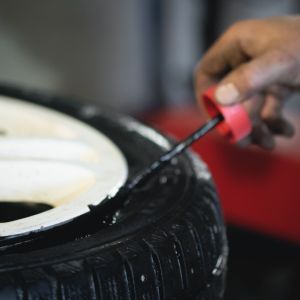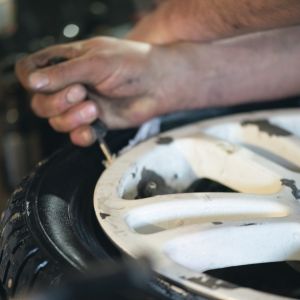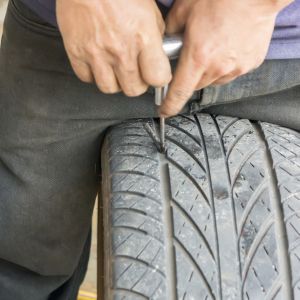Tyre sealant is a liquid solution made from latex, fibres and other ingredients designed to fix a puncture in a tyre and prevent further air loss. It is usually stored in a bottle or aerosol can and is applied through the valve stem of the tyre. The sealant is designed to seal small punctures as they happen and help maintain the pressure in the tyre for a short time.
Tyre sealants are a good option for those who want a simple and effective way to keep their tyres in good condition. Sealants are beneficial for those who live in areas where the roads may not be in the best condition and where the tyres may need extra protection from the elements.
What is a tyre sealant?

A tyre sealant is a liquid or gel-like substance that is used to patch up punctures or holes in tyres. It is made up of a rubber-based compound and intends to instantly harden and seal the puncture. The composition and quantity of each component can vary depending on the brand and type of sealant used.
The sealant is injected into the tyre through the valve stem using a provided tool. Immediately after the sealant has been injected, the tyre should be inflated to the required pressure and driven for a short distance to distribute the sealant and ensure that it completely seals the puncture.
When to use a tyre sealant?

Tyre sealants are best used when the tyres are already in good condition. This is due to the fact that sealants are not intended to fix worn or damaged tyres; in fact, they may make the situation worse. It is best to inspect the tyres for any wear or damage, such as bulges, cuts, or tears, before applying a sealant.
Another time when a tyre sealant may be beneficial is when a tyre is in need of extra protection. A sealant helps keep the tyre inflated and resist punctures from sharp objects on the road or from rocks and dirt.
How to use a tyre sealant to fix a puncture?

Using a tyre sealant to fix a puncture is a relatively simple process that can be done in a few steps:
- Locate the puncture: Before you start, you must find the puncture in the tyre. To do this, visually inspect the tyre for any indications of a tyre puncture, such as a nail or a shard of glass. A ruptured tyre can lose pressure, therefore you can also check the pressure using a tyre gauge.
- Prepare the tyre: The sealant needs to be prepared before being injected into the tyre. In order to do this, clean the area around the puncture and remove any material from it, such as glass or nails. You can do this by using the reamer tool provided in the repair kit.
- Inject the sealant: The sealant can then be injected into the tyre after it has been prepared. This is done through the valve stem using the tools. For details on how much sealant to use, refer to the directions on the package.
- Inflate the tyre: After the sealant is injected, you need to inflate the tyre to the correct pressure. You can use a tyre gauge to ensure that the tyre is properly inflated.
- Drive the vehicle: Once the tyre is inflated, you should drive the car for a short distance to spread the sealant and ensure that it properly seals the puncture. It is recommended to drive at a reduced speed and avoid high-speed driving.
- Check for leaks: Checking for leaks on a regular basis is important. The tyre may not be sealed properly if the pressure in the tyre drops or if the car pulls to one side. If so, you might need to add extra sealant or have the tyre professionally fixed.
Frequently Asked Questions
Q1. Explain in short the following: Can a tyre puncture be repaired after using a sealant?
Ans: Yes, tyre sealants are a convenient option for those who want an easy and effective way to keep their tyres in good condition. They are useful when the tyres are already in good condition, they don’t work on tyres which are damaged or worn.
Q2. How long does tyre sealant last in the tyre?
Ans: Depending on the type and brand of tyre sealant used, the lifespan can change, although it usually lasts between a few months and a year.
Q3. How do you use puncture repair kit sealant?
Ans: The sealant is injected into the tyre through the valve stem using the necessary tools. Immediately after the sealant has been injected, the tyre should be inflated with adequate air pressure and driven for a short distance to distribute the sealant and ensure that it completely seals the puncture.
Q4. Is tyre sealant a permanent fix?
Ans: No, tyre sealant is a temporary solution. If you want to fix the tyre permanently, it is better to get it fixed by a professional or change the tyre.
Q5. Can I drive with tyre sealant?
Ans: Yes, you can drive with tyre sealant, but it is recommended to drive at a reduced speed when the sealant is freshly applied.
Q6. How far can you drive on tyre sealant?
Ans: It depends on the type and brand of sealant used, but you should be able to drive for a few miles to a few hundred miles before needing a permanent repair.
Q7. Does tyre sealant damage tyres?
Ans: No, tyre sealant is designed to repair punctures without damaging the tyre. It is meant to fill small holes, preventing air from escaping, so that the tyre can maintain its pressure and continue to perform as intended.
Q8. What is the disadvantage of tyre sealant?
Ans: The main disadvantage of tyre sealant is that it repairs the puncture temporarily. It might be difficult to clean the tyre sealant out of the tyre and it may clog the valve and tire tread. Tyre sealant can also damage the tyre and wheel rim, and it can make it difficult to detect other potential tyre problems.

